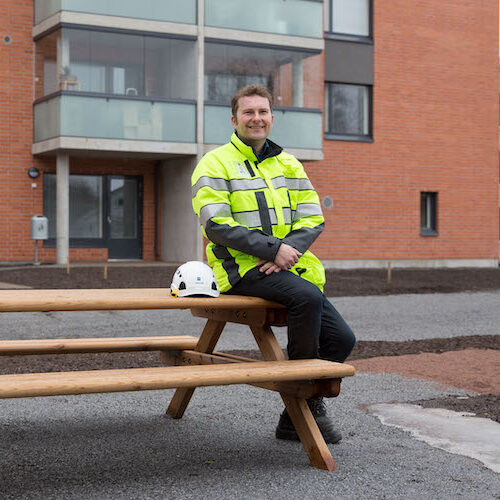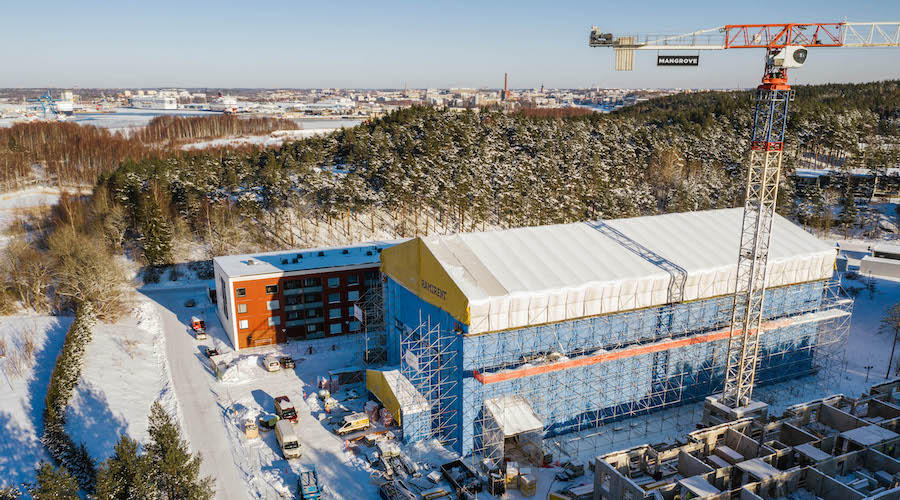Two identical-looking buildings are rising in Arola, Turku. This time, however, looks are deceiving: one building is made of wood and the other of concrete. They are built in a project comparing the environmental effects of construction materials. The project is managed by TVT Asunnot, a housing provider owned by the City of Turku.
“The city aims to be carbon neutral by 2029, and this is one of our ways to contribute towards that goal. As a company with social relevance, we have an opportunity to experiment”, says Johannes Malmi, development director at TVT.
Using wood for construction is nothing new, but this is the first wooden apartment building built by TVT.

“We have nearly 500 apartments in old wooden buildings, built in urban areas in the early 1900s. Wood is a very common construction material, but other materials have been more popular in large buildings in recent decades”, notes Teppo Forss, CEO at TVT.
The project to construct the seemingly identical but internally different buildings was initiated three years ago. The work has progressed according to schedule, and residents should be able to move in at the end of this year. The traditional celebration marking the completion of the roof was held this May, although only in a small way due to the still ongoing coronavirus pandemic.
At the moment, the wooden construction has progressed slightly further than the concrete one, and the construction sites look different because the wood frame is built under a weather cover to protect it from rain.
“If you hear music blasting from under the cover system, that’s just the builders in their natural habitat”, Malmi chuckles, also noting that the wooden construction is looking very nice and convincing so far.
The finished buildings will not only look very similar, but they will also have almost identical floor plans. The wooden building uses cross-laminated timber, and only a very keen eye can see that it has slightly larger outer dimensions for technical reasons. The design and type of structure of the buildings, however, is entirely different, resulting in different acoustics and fire safety solutions, for example.
“We left some wooden parts visible as a visual element, especially in the walls that have windows. We would have liked to leave even more, but couldn’t because of fire safety reasons. We also used some concrete as a visual element in the concrete building”, Forss explains.
Learning from other projects
The two buildings are monitored in many ways. Their construction waste is known by the kilogram, their carbon footprint and handprint are calculated carefully, and their energy use is measured and compared. Resident surveys will be conducted frequently, for example to find out how residents experience the sounds and acoustics in the buildings. Malmi is also looking forward to finding out if one of the buildings will prove more popular in residential applications.

According to Malmi, neither of the two different construction materials required any significant compromises, but the wooden building was somewhat more expensive to construct.
“Unlike in concrete construction, ready-made packages are not available for large timber construction, so orders have to be customised individually. Volumes are also smaller and suppliers don’t have as much competition as there perhaps ought to be. This makes wooden construction more costly”, Malmi summarises.
Before initiating the project, TVT studied a similar project by A-Kruunu, including their environmental calculations.
“We had access to this information from an excellent Finnish example that we could make use of. We developed our carbon footprint calculations and added resident satisfaction as a measured goal based on A-Kruunu’s project”, Forss reports.
Forss and Malmi agree that the project was a learning experience that will likely yield rewards long after the construction phase. They are eager to share their experiences and have received inquiries also from outside Finland.
“Better homes, one building at a time”
So far, TVT’s experience in constructing a wooden apartment building has been a positive one, and worth considering in the future, too.
“Unfortunately, urban planning prohibits wooden apartment buildings in many areas in Turku. Even this project required changes to town plans. It seems that urban planning follows changes in regulation very slowly and does not encourage experimenting”, Malmi comments.
Forss emphasises that non-profit companies must build long-lasting homes that are safe and healthy to live in. He has a neutral approach towards the construction materials: “It is important for us to use proven materials and construction practices that have been tried and tested. Experiments must therefore be kept limited in number, but when the construction volume is large and there is a high level of know-how involved, the experiments tend to be successful.”
This experiment in wooden construction is one of TVT’s steps towards carbon neutrality, and the company also watches the development of the concrete industry closely. TVT implements numerous sustainability measures throughout the building’s entire lifecycle, from land acquisition and construction to habitation and renovation. Residents are encouraged to take climate action through waste, heat and water consumption practices.
In addition to environmental measures, affordability is another major point of consideration. Many rental apartments have recently been built in Turku and many more are planned, but housing is nevertheless becoming more and more expensive, which is a worrying trend.
“Every sector of the city should give thought to how we could make housing more affordable. The process from town plans to finished apartments is a long one, and costs can be affected throughout the entire process. It is our own city that we’re building, and we should remember that”, Malmi states.
“It is important for us to make apartments that the residents can afford and enjoy. In the best case, we can do so while also developing methods that have wider social benefits. We are building better homes, one building at a time”, Forss concludes.
Carbon footprint
Carbon footprint refers to carbon dioxide emissions caused by human activity. In most cases, it is reported in carbon dioxide equivalent (CO2e), which also accounts for other significant greenhouse gases, most importantly methane (CH4) and nitrous oxide (N2O).
Carbon handprint
Carbon handprint describes the climate benefits of a product, process or service. Anyone can create a carbon handprint – a state, a company, an association or an individual. For example, when a company generates a carbon handprint for its customer, the customer can reduce their own carbon footprint.
In addition to developing their own operations, companies can improve their carbon handprint by actively introducing to the market new innovations, products, solutions or services that generate positive environmental impacts during their use. Many solutions of circular economy produce their customers a carbon handprint when compared to a similar, more conventional solution.
The carbon handprint highlights the positive future effects on emissions, whereas the carbon footprint focuses on the negative effects on emissions.
Written by Hannele Borra
Photos by TVT Asunnot




